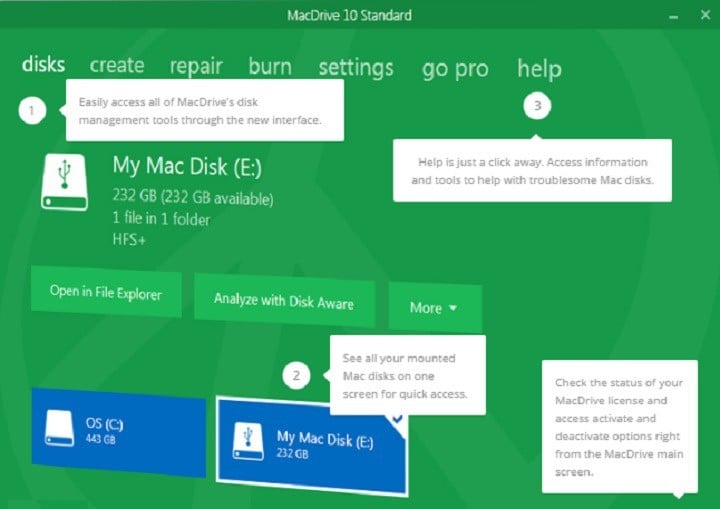Disk Repair Tool For Mac On Windwos
Cumbersome tasks that usually have to be dealt with manually are automatized. GNU General Public License (GPL) Size: 0 License: Freeware For searches similar to web add in extensibility toolkit for qtp see 'Related Downloads' under the categories listing. GNU General Public License (GPL) Size: 257.1 KB License: Freeware Data Added 1: March 22, 2013 A Microsoft Outlook COM Add-In that provides vCard export and MailMerge functional for contacts. GNU General Public License (GPL) Size: 0 License: Freeware Data Added 1: May 29, 2013 The PPT-Pixy is an add-in for MS Powerpoint that aims at alleviating some of its shortcomings. Qtp tool download for mac. Remote objects are serialized in a standard XML format, and they are accessible trough their own URL.
Due to logical bad sectors, a data is at risk. Thus, by executing a Disk Repair software a logical bad sector is barricaded and successfully repairs Track 0 Bad Disks. Logical bad sectors are the major turn-offs in the hard disks, mainly evolve on the magnetic media formed because of extensive read write operations and so on. Disk Repair effectively abolishes and repairs logically formed bad sectors from the hard disks and supports: FAT12, 16, 32, VFAT, NTFS and NTFS5 File system and moreover all the versions of MS Windows.
Full Specifications What's new in version 10.x Software is updated and support window 7 and 8. General Publisher Publisher web site Release Date July 24, 2013 Date Added January 16, 2007 Version 10.x Category Category Subcategory Operating Systems Operating Systems Windows 98/Me/NT/2000/XP/Vista/7/8 Additional Requirements None Download Information File Size 696.4KB File Name DiskRepairDemo.zip Popularity Total Downloads 114,655 Downloads Last Week 128 Pricing License Model Free to try Limitations Limited functionality Price $134.

I experienced an extremely nettlesome problem after swapping out my traditional hard drive for a faster ( SSD). I, copied over all my software ( but I was too lazy) and then mindlessly enabled a bunch of options that I never enabled before. Stupidity has a cost and in my case it cost hours of discomfiting nights scouring Google for a solution.
Disk Repair Software For Mac
OS X’s Disk Utility—which enables you to format, partition, repair, and perform other kinds of maintenance on disks (including SSDs, flash drives, and disk images)—is good for what it does.
Disk Repair Tool For Mac On Windows
Today I want to save you the pain I encountered by showing you how to fix a problem I experienced in VirtualBox. This post is going to be succinct and to the point. Even though my Host OS is a, VirtualBox categorically refused to display any 64-bit guest OSes in the Create Virtual Machine dialog box. This was super annoying because all my ISOs were 64-bit therefore I couldn’t use them until I fixed this problem. Uninstalling and reinstalling VirtualBox made no observable difference so I booted into the BIOS to see what I could find there. I have a Lenovo ThinkPad W520.
As a side note, a few months ago I made another idiotic mistake: I enabled a bunch of BIOS passwords to make myself feel secure but then forgot how to disable them! Thank God I didn’t enable a Supervisor Password or else I would have to replace the system board. That’s seriously the only way to get around that one; resetting the CMOS won’t fix a forgotten Supervisor password. Thankfully, I remembered, the Hard Drive password and the Power-On Password, so after surmounting those obstacles, I removed those passwords and tried to see if there was anything I could enable to make VirtualBox display 64-bit Guest OS versions. In the Security Section, I noticed an option called Virtualization. Filled with a bracing hope, I tabbed over and hit enter but then noticed all relevant settings were already enabled! Intel (R) Virtualization Technology was enabled and Intel (R) VT-d Feature was also enabled.

These were two key options that VirtualBox was expecting. But since both were already enabled I was utterly flumoxed. Do I need to toggle the values? In other words, do I need to disable both options, save changes, reboot, and then enable them again? I couldn’t figure it out so I decided to poke around the administrator options in Windows to see what I could find. I wanted to see what administrative Windows features were enabled – perhaps something was conflicting with the visualization settings in the BIOS?
I quickly pressed Windows Key + q to open the Search box and typed in: turn windows features on or off I scanned a few options but one in particular was salient: Hyper-V was enabled. In Windows 8.1 Hyper-V is the successor to Microsoft Virtual PC. It’s the native virtualization component that is available to all Windows 8.1 users. It was enabled though Interesting. Could this be conflicting with the Intel settings in my BIOS?
I decided to uncheck the option to see. Windows quickly displayed a progress bar denoting the removal of the Hyper-V platform and after about a minute prompted me to reboot. When my system came back up, I swiftly logged back into the Windows, kicked open VirtualBox and checked the versions list: Yes yes yes!!!! I couldn’t have been more elated – something like this might seem trivial to some people but it was really worrying me. Because it used to work before I upgraded my hard drive.
It turns out, upgrading my hard drive wasn’t even remotely causally related to my problem. I think I literally pumped my fists in the air when I saw this screen. The Bottom Line If VirtualBox is only showing 32 bit versions in the Version list make sure: • Your Host OS is 64-bits • Intel Virtualization Technology and VT-d are both enabled in the BIOS • The Hyper-V platform is disabled in your Windows Feature list. I hope this helps you – I don’t know if my situation will apply to your system configuration but I wanted to share.